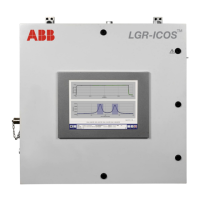GLA531 Series LGR-ICOS™ Gas Analyzer
Operating Manual
3KXG165002R4201_2021_04
ABB PROPRIETARY INFORMATION 42
6 Purged-and-Pressurized Protection
System for Flammable Gas
(This section is not applicable for General-Purpose analyzers)
The purging-and-pressurizing method is one of the most versatile protection systems for preventing explosion
and fire hazards. This system is based on the principle of removing flammable gas from the enclosure by an
initial purge process, and maintaining an overpressure with continuous flow of a protective gas. Analyzers for
hazardous-location installations offer two choices of protective-gas options: compressed dry air (CDA) continuous
dilutions, or dry nitrogen gas (N
2
) leakage compensations.
• CDA contains oxygen. However, each combustible gas ignites in a specific range of concentration. If the
concentration is too low (lean mixture), or too high (rich mixture), it will not ignite, and explosion will not
occur. Based on this principal, ignition or combustion can successfully be prevented by continuously
diluting the atmosphere inside the enclosure and keeping its concentration below the lean-mixture level.
This method typically requires specific calculation of the dilution ratio for each flammable-gas type.
• Because N
2
is an inert gas that does not contain oxygen, ignition or combustion can effectively be
prevented inside a nitrogen-filled enclosure. In this case, the protection system only requires a minimal
flow of nitrogen for maintaining an overpressure inside the enclosure, as a leakage compensating flow
of protective gas. The flow rate of N
2
mainly depends on the leak rate of the enclosure itself.
Flammability limits of gases are most commonly expressed in terms of volume percentage (Vol.%), at 25
o
C and
atmospheric pressure. The lower limit is usually defined as Lower Flammability Limit (LFL). Each flammable gas
has a different level of LFL, as shown in the LFL row in Table 10 below. The protection system of ABB GLA531
Series LGR-ICOS™ Gas Analyzer maintains a dilution ratio below 25% of LFL for each specific flammable gas,
to ensure safety. For an example of a hydrogen process-gas application in Table 10 below: the LFL for hydrogen
is 4%, so the target of dilution rate is below 1% of volume, which is 25% of 4%.
Table 10 Typical CDA Purging Design for GLA531 Series Protection System
Process Gas Hydrogen Natural Gas Ethylene
*Non-
Flammable
LFL (Vol.%) 4 4.8 2.7 N/A
<25% of LFL Target < 1 <1.25 < 0.68 N/A
Maximum Intake to
Enclosure, (sccm)
430 824 610 824
Enclosure Overpressure,
Inch-WC (mBar)
0.2 - 5.76
(0.5 - 14.33)
0.2 – 8.04
(0.5 – 20.00)
0.2 – 10.32
(0.5 – 25.68)
0.2 - 5.76
(0.5 - 14.33)
Purge Air Flow Rate,
SCFM (lpm)
2.23 (63.1) 2.85 (80.7) 3.58 (101.4) 2.10 (59.46)
Purge Air Regulated
Pressure, PSIG (kPa)
25 (172.4) 25 (172.4) 35 (241.3) 25 (172.4)
CDA Supply Minimum
Pressure, PSIG (kPa)
35 (241.3) 35 (241.3) 45 (310.3) 35 (241.3)
*When used in a flammable-gas environment, a non-flammable analyzer requires a protection
system enclosure.

